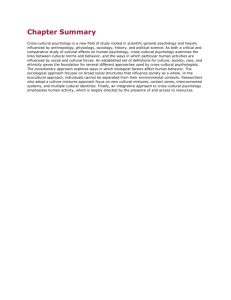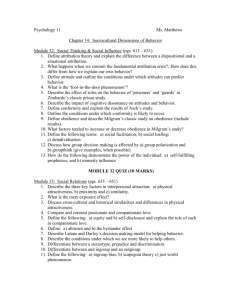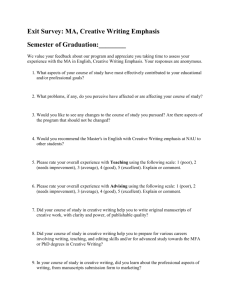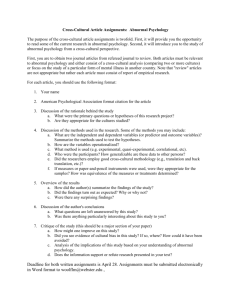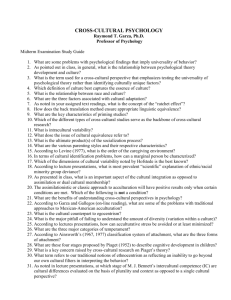JOURNAL OF CROSS-CULTURAL PSYCHOLOGY
advertisement
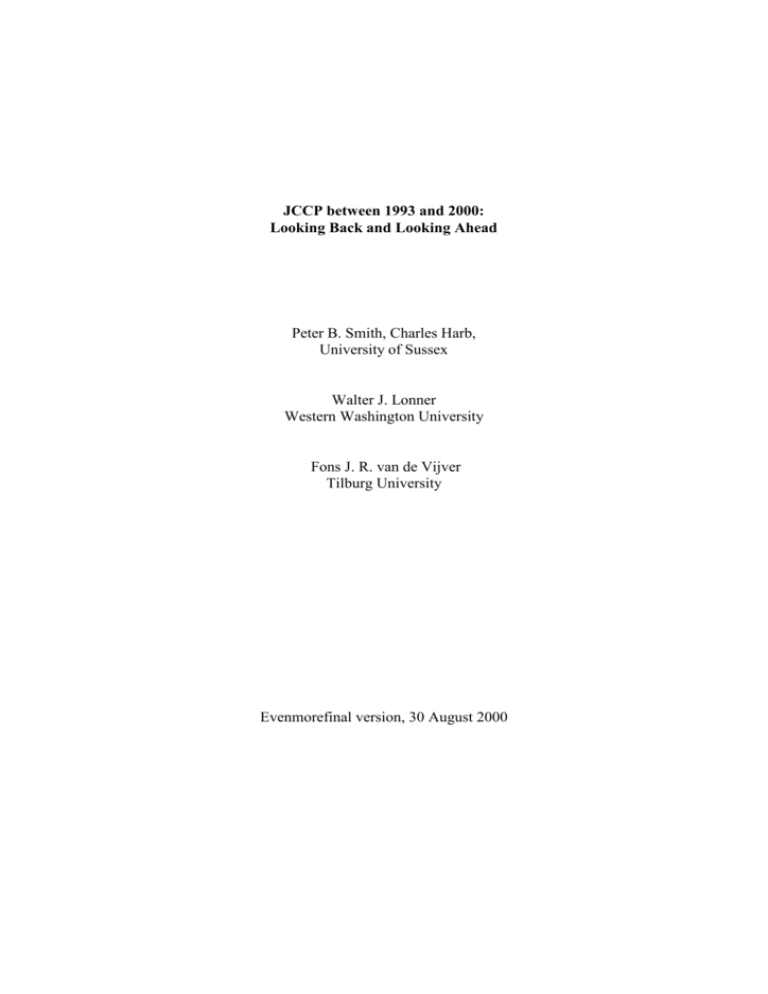
JCCP between 1993 and 2000: Looking Back and Looking Ahead Peter B. Smith, Charles Harb, University of Sussex Walter J. Lonner Western Washington University Fons J. R. van de Vijver Tilburg University Evenmorefinal version, 30 August 2000 2 This issue marks the beginning of the 32nd volume of the Journal of Cross-Cultural Psychology (JCCP). We say this with both pride and humility, and also with considerable optimism about its future. Inaugurated in 1970 as a quarterly publication and with the dedication to ". . . consult all that is human" (part of our initial masthead policy), the judgment was made then that it was time for psychology to give serious, concentrated attention to culture as an essential ingredient in the understanding of human behavior. Indeed, the inauguration of JCCP was one of several developments that took place in psychology during the mid- to late-1960s in which culture played an integral part. While one may speculate why that particular period fostered the development of cross-cultural psychology, we can say with certainty that the true measure of a mature science of human behavior is the extent to which it intentionally seeks to incorporate the broadest possible spectrum of humankind when formulating ideas about the causes and consequences of human behavior. With the exception of some psychologists who hold an absolutistic view of the world, it is clear that psychologists across the globe now recognize the importance of culture in shaping and maintaining human conduct. One can also say with certainty that it has yet to be determined exactly how and when culture and ethnicity affect human thought and behavior. For many years cross-cultural psychologists have developed models, frameworks, and a host of theoretical propositions, to help explain these connections. Other culturally-oriented psychologists have similarly developed perspectives on the role that culture plays in human activity. In fact, one of the most striking developments in the past decade has been the growth in number of individuals who represent different epistemological perspectives in the area of psychology and culture. Thus we have, in addition to cross-cultural psychology, the orientations of cultural psychology, indigenous psychology, and psychological anthropology. The common denominator in these approaches, which have fuzzy boundaries between them, consists of 2 3 making attempts to explain how and why behavior appears in specific cultural contexts. With these perspectives comes a rather formidable list of potential problems and questions that have been the center of interesting debates. For example, is the best approach the culturecomparative perspective, which is largely, but not exclusively, featured by the classical crosscultural method? Or is comparativism potentially so fraught with difficulties, including how to deal with selecting samples and how to make various stimuli equivalent across different psycholinguistic groups, that only intense and extremely context-dependent approaches should be attempted? These issues and debates will continue. We believe that an important way to shine some light on them and on the role of JCCP in them is to monitor the content of the manuscripts that we receive and to contrast those that are accepted for publication with those that are not. Similarly, we believe that it is important to analyze trends and developments. As the flagship publication of cross-cultural psychology, we believe that an analysis of the content of this Journal can be instructive to both readers and those who evaluate the results of cross-cultural research. Periodic analyses like these allow us and our readers to reflect on where we have been and where we are going. For this purpose, we offer the following brief analysis. Trends in Submissions and Acceptances A content analysis of papers accepted and rejected by JCCP over the past seven years is presented; it parallels an earlier analysis of papers published between 1970 and 1993 (Öngel & Smith, 1994). The analysis presented here covers papers published or accepted for publication by mid 2000, in order to address two key questions. Firstly, what evidence is there that the papers published in JCCP reflect an increasingly broad cross-cultural focus? More specifically, is there an increase in the locations of authors, the spread of topics, the research sites and populations sampled? Whether such changes have occurred is partly dependent on 3 4 the types of submissions JCCP receives and partly on the decisions made subsequently by the editorial team. This leads to the second question: What differences are there between the submissions that JCCP accepts and those that it does not accept? The present analysis thus differs from the earlier analysis by Öngel and Smith (1994), in that it includes a sample of rejected papers. During the seven-year period under scrutiny, 279 papers were accepted for publication, whereas 665 remain under review or were not accepted. This implies a 29% acceptance rate. However, 21 accepted papers were invited contributions to special issues, so a more accurate rate for acceptances of unsolicited submissions is 27%. This rate has declined to nearer 20% in the most recent years, due to substantial and continuing increase in the number of submitted manuscripts. The data reported below are based upon sampling of all accepted papers and a one-third random sample of nonaccepted papers. - Insert Table 1 about here Table 1 shows the country of residence of the participants. The eight most frequently sampled nations are exactly the same as found for the preceding 15 year period. During 19801993, the eight most frequently sampled nations accounted for 62% of all samples, compared with 59% for the past 7 years. Within this group there is a marked increase in sampling of China (now including Hong Kong), balanced by a modest decline in sampling of the United States, Australia and Israel. The middle section of the table (India to Brazil) indicates the nations that have been next most strongly represented in recent years. There is no difference between acceptance and rejection rates for groups of nations whose sampling frequency is high, medium or low (Chi square = 0.37, df = 2, ns), indicating that editorial policy has not favored studies that sample any particular type of nations. - Insert Table 2 about here 4 5 We next consider what change there has been in the types of study submitted and accepted. A distinction is made between studies reporting cross-national comparisons, studies comparing two or more cultural groups from within a single nation, and single-sample studies. Table 2 shows that there has been a substantial increase in cross-national comparisons. The numbers of studies comparing samples within a single nation has held steady, but singlesample studies from within a single nation have declined sharply. Chi square for submissions of the three types of studies is 32.0 (df = 2, p < .001). This effect may be attributable to changing patterns of submission, differences in manuscript quality across these types of studies, and editorial policy, since the pattern of acceptances also differs significantly from the pattern for rejected papers (Chi square = 40.91, df = 2, p < .001). - Insert Table 3 about here A third issue to be explored is whether the range of author locations has increased. Table 3 shows a large decrease since the previous survey in the percentage of authors located in the United States. This need not necessarily imply a lesser involvement of US researchers in studies published in JCCP. The decrease could equally well be explained by the increased frequency of teams of co-authors from within and outside of the United States. Authors from almost the same eight nations continue to predominate, with Netherlands replacing UK. The top eight nations accounted for 82% of all authors in the earlier period, declining to 67% in the last seven years. This decline is largely attributable to a 15% reduction in US authorship, to some extent balanced by a 9% increase in authorship by researchers from the infrequently represented nations that are shown at the bottom of the table. The changes in authorship appear at least in part to be attributable to quality of the manuscripts and editorial policy, since the acceptance rate for authors at different locations shows a clear pattern. There is a significant difference for acceptance rates for the top eight nations compared with rates for the next most strongly represented group of nations (United Kingdom to Russia) and for the least 5 6 frequent group (Chi square = 11.17, df = 2, p < .01). Authors in the middle group of nations achieved a higher acceptance rate. Papers from authors from the United States and Australia were more frequently rejected, as well as those from the least frequently represented nations. However it is not likely that this effect is simply attributable to author location. It is more probable that a higher proportion of the rejected papers used different types of samples or focused on distinctively different types of topic. These possibilities are now explored. - Table 4 about here Table 4 shows the locations of authors for different types of studies published since 1993. As could be expected, submissions involving nations that are more ethnically diverse have yielded a higher proportion of successful submissions with a within-nation design. This profile is particularly marked for the Canada, Israel and Australia. Successful submissions of single-sample studies were more often from infrequently represented nations. However, as was shown in Table 2, studies with cross-national designs have achieved the highest success rate, and it is therefore not surprising that authors from nations who mostly submitted this type of study achieved the highest success rates. The review by Öngel and Smith (1994) showed a trend toward increasing emphasis within JCCP on social psychological topics. Table 5 appears to indicate that this tendency has been arrested and indeed reversed. However, the figures in the table most probably reflect a difference in the coding procedures employed. In the Öngel and Smith analysis, each study was assigned to a single topic category. In the present analysis, multiple codings were permitted, in order to reflect the fact that many studies spanned more than one category. The 511 codings in the accepted paper column are based upon 279 accepted papers, whereas the 296 codings in the rejected papers column are based upon the one-third sample of 180 rejected papers. The present analysis also included a category (‘cross-cultural theory based’) which was not present in the earlier analysis. Studies coded into this category were those based upon 6 7 theoretical formulations that are explicitly cross-cultural (such as individualism-collectivism), rather than drawn from some other area of psychological theory. - Table 5 about here The data in Table 5 suggest a broadening of the range of topics that achieve acceptance, with a corresponding decline in coverage of social psychology, personality and methodological issues. Comparison of the percentages for accepted and rejected submissions indicates that submissions in the areas of clinical psychology have been least likely to succeed, followed by manuscripts dealing with acculturation, organizational psychology, and counseling. Submissions in the area of social psychology and especially those that are explicitly based on cross-cultural theory have a significantly higher success rate (Chi square = 7.65, df = 2, p < .05). However, a further analysis of the 79 submitted manuscripts that were based on cross-cultural theory yields further important information. Of these 79, 39 were in the areas of social psychology and personality. Seventy-four percent of these achieved publication. Of the remaining 40 manuscripts based on cross-cultural theory, 77% achieved publication. Thus, it is reliance upon theory rather than the topic area within psychology that yields enhanced chances of acceptance. - Table 6 about here A final issue of interest is whether there has been any change in the types of participants in the studies under review. Table 6 indicates an increase in the proportion of accepted papers that are based on sampling of students and a smaller decrease in the proportion of mixed samples. There is also a difference between the percentages for different types of participants between accepted and rejected papers (Chi square = 12.57, df = 5, p < .05). Submissions sampling adults have been less successful. Implications 7 8 This paper has provided a brief analysis of recent trends in the submission of manuscripts to JCCP, together with data pertaining to patterns of acceptance and rejection. We have also included information about types of study, authors, and the participants sampled in the various research projects. During the period covered we have seen a striking increase in submitted manuscripts as well as trends some of which are stable over time while others show more variation. The list of most frequently sampled countries is stable. In particular, the USA features prominently in this list, with 1/4 of all samples coming from this country. The proportion of accepted papers and the countries sampled were found to be independent of one another, despite the many concomitant variables that could connect them, such as the nature of samples and the topics studied. Some years ago, the intent and scope of JCCP’s original masthead policy was expanded, to show that our interest in helping to explain the connection between culture and the thought and behavior of individual was broad-banded. This expansion included the following sentence: “Submitted manuscripts may report results from (…) types of research concerning the ways in which culture (and related concepts such as ethnicity) affect the thinking and behavior of individuals as well as how individual thought and behavior define and reflect aspects of culture.” (quoted from the journal’s cover; the text can also be found at the journal’s Internet site: http://www/iaccp.org/JCCP/jccp.html). This expanded version of our original intent has not succeeded in attracting many strong manuscripts from those who seem to identify with cultural psychology. Quite to the contrary, as our analyses show, there has been a substantial increase in cross-national comparisons. Different explanations for this can be envisaged. It is not a likely explanation that this evaluation follows the formulation of the new masthead policy too soon, as prior to the modification of the masthead policy cultural psychological manuscripts were already being submitted and published. It is more likely that within the overall increase in cross-cultural studies during the past decade (among which are 8 9 many comparative studies), JCCP has received a relatively larger proportion of submissions based on comparative studies. In the eyes of potential authors, JCCP was and apparently still is the journal of culture-comparative studies. Assuming that the quality of these manuscripts has not decreased while their quantity has increased, they have inevitably taken a larger share of the journal’s available space. The new category in our content analysis of theory-based cross-cultural research defines an important new area of publications, which we expect will gain further prominence. These studies often use a systematic sampling of cultures in order to examine cultures that differ on some focal variable, often Individualism—Collectivism. These publications delineate a new generation of studies; we are slowly moving beyond the stage in which cultures are sampled on the basis of convenience rather than theory. The quality of submitted manuscripts, journal impact factors, and rejection rates tend to reinforce each other, either in a positive or a negative direction. In the period of this review they have positively reinforced each other. Members of the Editorial Board who have served for some years know that the quality of the submitted papers has gone up in recent years. Our analyses revealed an increased rejection rate. Finally, the impact factor of JCCP has increased. The 1999 impact factor is 1.000, which is one of highest ever for this journal. This trend is undoubtedly more appealing to the Editorial Board than to potential authors. Manuscripts submitted to JCCP now have an a priori probability of about .20 of being published in this journal. This acceptance rate is low, though not uncommon in psychology journals. An important outcome of this analysis involves the role of social-psychological studies. In previous content analyses we found the social-psychological domain to be heavily represented. This has been important throughout the history of cross-cultural psychology. Clearly, social psychology is an area of pre-eminent importance to cross-cultural psychology; 9 10 yet, if JCCP aims to represent all major areas of cross-cultural research, we have made some progress in this direction. It is notable that manuscripts coming from the more applied domains of cross-cultural psychology, such as acculturation, counseling and organizational psychology often do not survive the review process. An important reason may be the emphasis on fact-finding and the atheoretical nature that often characterizes these papers. It is encouraging that submitted manuscripts in these less frequently studied areas that are theory-driven have a higher success rate than those in the area of social psychology. As researchers in these fields become more often able to integrate existing theories or to develop new ones, more of these papers will receive positive evaluations from reviewers and will appear in JCCP. We hope to see more submissions in these areas in coming years, and to publish them. What are our publication plans for the future? No major changes are to be expected. The vast majority of articles to be published will be unsolicited submissions of studies that are in line with our masthead policy. We would like to emphasize that we welcome the trend whereby all major domains of cross-cultural research are represented in JCCP. The main criteria for evaluating manuscripts will continue to be the quality of theory, design, analysis, and write-up. In addition, special issues will be published and these will focus on promising domains of theory and research in cross-cultural psychology. Finally, we will invite crosscultural researchers to submit reviews or reports of recently completed studies. It is important for professional journals to monitor trends and to report them for the benefit of their readers. This should be, and usually is, a job that is done by the editors of such publications. It is even more important to do this for JCCP. As the flagship journal of the modern development of cross-cultural psychology, analyses of various patterns should give us some solid insight into where have been and what may lie ahead, as this area of psychology continues to flourish and to define its core concerns. 10 11 Reference Öngel, U. & Smith, P. B. (1994). Who are we and where are we going? JCCP approaches its 100th.issue. Journal of Cross-Cultural Psychology, 25, 25-53. 11 12 Table 1: Country of Residence of Participants Sampled in Research Projects Percentage accepted 1993-2000 24.8 10.0 5.3 4.5 4.0 3.8 3.6 3.0 Percentage rejected 1993-2000 27.6 9.8 6.5 2.9 1.5 1.8 7.6 2.5 Percentage published 1980-1993 28.0 5.6 6.3 3.8 3.4 5.8 5.6 3.1 India Taiwan Korea Netherlands Italy Philippines Russia Turkey Mexico Finland Singapore Nepal Indonesia Greece Poland South Africa Spain Brazil 2.3 2.3 2.1 1.9 1.9 1.5 1.5 1.3 1.3 1.3 1.3 1.3 1.0 0.8 0.8 0.8 0.8 0.8 1.8 1.8 1.8 1.5 0.0 0.7 2.2 0.7 1.8 0.7 2.5 0.0 1.1 0.7 0.7 3.3 2.2 0.4 2.5 2.2 1.6 1.4 1.1 1.6 0.0 1.4 2.3 0.0 0.0 0.0 0.0 1.6 1.4 2.2 0.0 0.9 Othera 15.4 15.6 18.1 Frequency 468 825 552 Country United States China (incl. Hong Kong) Japan Canada Germany Israel Australia United Kingdom Note. Only 1/3 of rejected manuscripts were sampled. Frequencies in the rejected column have been multiplied by three to estimate the full sample values. The names of nations sampled three times or less refer only to the accepted papers column. The 19 studies that sampled more than 10 nations were not included in the analysis. a Czechia, Estonia, France, Hungary, Sweden (3 each), Bangladesh, Bulgaria, Cyprus, Denmark, Ghana, Jamaica, Malaysia, Norway, Sri Lanka, Switzerland, Thailand, UAE (2 each), Angola, Argentina, Barbados, Belgium, Chile, Congo, Costa Rica, Costa Verde, Croatia, Egypt, El-Salvador, Ethiopia, Georgia, Grenada, Ivory Coast, Kenya, Kuwait, 12 13 Mozambique, New Guinea, Nicaragua, Nigeria, Oman, Palestine, Pakistan, Peru, Portugal, Romania, Saudi Arabia, Slovenia, Trinidad, Uganda, Zambia, Zimbabwe (1 each) Table 2: Manuscripts associated with Four Types of Research Design Percentage accepted 1993-2000 Percentage rejected 1993-2000 Percentage published 1980-1993 Cross-national 54.5 33.9 38.1 Within-nation 26.2 32.2 23.6 Single nation 10.4 25.0 27.1 Review 9.0 8.9 11.3 Frequency 279 540 373 Note. Only 1/3 of rejected manuscripts were sampled. Frequencies in the rejected column have been multiplied by three to estimate full sample values. The categories ‘within-nation’ and ‘between-nation’ have been used, due to the absence in many papers of evidence as to whether a sample might be considered monocultural or multicultural. 13 14 Table 3: Location of All Authors of Accepted and Rejected Manuscripts Percentage accepted 1993-2000 Percentage Percentage rejected published 1993-2000 1980-1993 United States China (incl. Hong Kong) Canada Japan Israel Australia Germany Netherlands 34.2 7.5 5.0 4.5 4.3 4.3 4.1 3.9 40.2 8.3 4.6 4.6 2.1 8.3 1.2 2.1 49.1 4.6 5.8 3.1 5.4 6.6 4.0 2.6 United Kingdom India New Zealand Korea Taiwan Turkey Italy Mexico Finland Poland Nepal Russia 3.6 1.8 1.8 1.8 1.6 1.4 1.4 1.4 1.4 1.1 0.9 0.9 2.9 1.2 1.7 2.1 1.7 0.4 0.0 0.4 0.0 0.8 0.0 0.8 1.8 0.9 0.9 0.2 0.9 0.8 0.8 1.1 0.2 0.6 0.0 0.0 Other1 13.2 16.6 10.6 Frequency 441 723 845 Note. Only 1/3 of rejected manuscripts were sampled. Frequencies in the rejected column have been multiplied by three to estimate the full sample value. The author locations sampled three times or less refer only to the accepted papers column. Two papers with over ten authors were excluded from the analysis. 1 Brazil, France, Hungary, Norway, Philippines, Singapore, Spain, Switzerland, Sweden (3 each), Bangladesh, Czechia, Greece, Indonesia, S. Africa, (2 each), Angola, Argentina, Belgium, Bulgaria, Chile, Cyprus, Estonia, Ethiopia, Costa Rica, Croatia, Ghana, Jamaica, Kenya, Oman, Namibia, Portugal, Slovenia, UAE, Uganda, Venezuela, Zimbabwe (1 each) 14 15 15 16 Table 4: Author Locations for Three Types of Published Studies United States Percentage single sample 5.2 Percentage Percentage within between nation nations 21.6 85 Country total 116 Canada 0.0 33.3 14 21 Australia 5.9 41.2 9 17 Israel 11.1 38.9 9 18 China (incl. Hong Kong) 2.4 14.3 35 42 Japan 12.0 4.0 21 25 Germany 0.0 5.3 18 19 All others 16.7 18.7 62 96 Frequency 29 72 253 354 16 17 Table 5: Submission and Acceptance Data by Topic Percentage published 1993-2000 Percentage rejected 1993-2000 Percentage published 1980-1993 Social 28.2 24.0 51.5 Cross-Cultural Theory-Based 10.6 6.1 - Personality 8.4 8.1 12.8 Developmental 7.8 6.8 5.6 Acculturation 5.7 9.5 2.1 Clinical (includes health and counseling) 4.1 12.2 0.4 Cognition 7.0 5.7 6.9 Education 4.5 6.8 1.6 Psychometrics 3.9 6.4 1.6 Methodology 4.4 2.7 13.6 Organizational 3.3 5.1 0.3 Language 4.1 1.0 1.6 Perception 1.8 1.0 1.3 Other 6.2 4.7 0.5 Frequency 511 888 373 Note: Only 1/3 of rejected manuscripts were sampled. Frequencies in the rejected column have been multiplied by three to estimate the full sample value. 17 18 Table 6: Composition of Samples in Accepted and Rejected Manuscripts Percentage Percentage published rejected 1993-2000 1993-2000 Percentage published 1980-1993 Young children 13.8 9.8 17.3 Adolescents 10.3 11.7 14.6 Students 43.5 42.3 31.9 Adults 22.1 30.6 22.9 Mixed 6.3 3.7 13.4 Secondary sources 4.0 1.8 0.0 Frequency 253 489 373 Note. Non-empirical studies are omitted. Only 1/3 of rejected manuscripts were sampled. Frequencies in the rejected column have been multiplied by three to represent the full sample. 18
